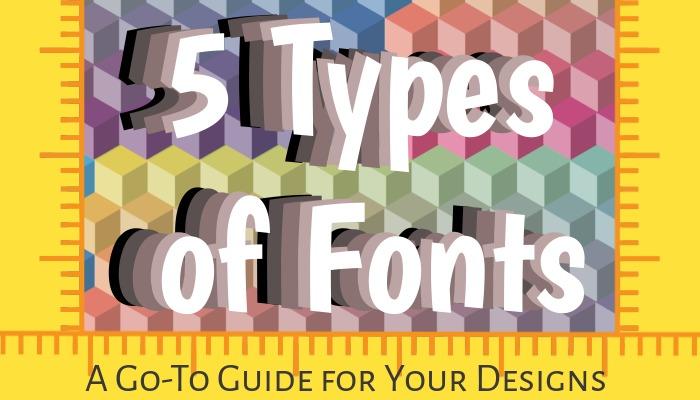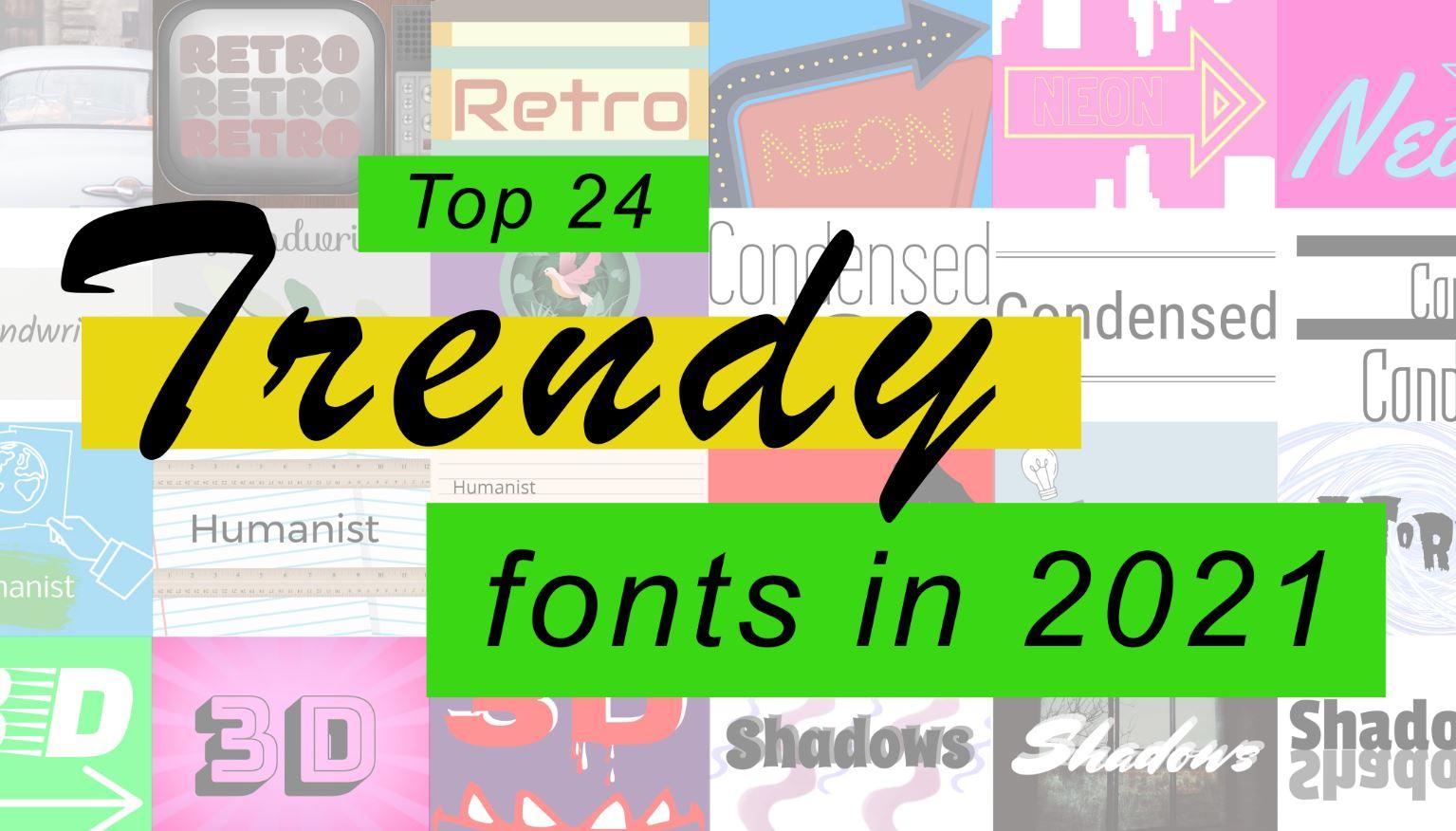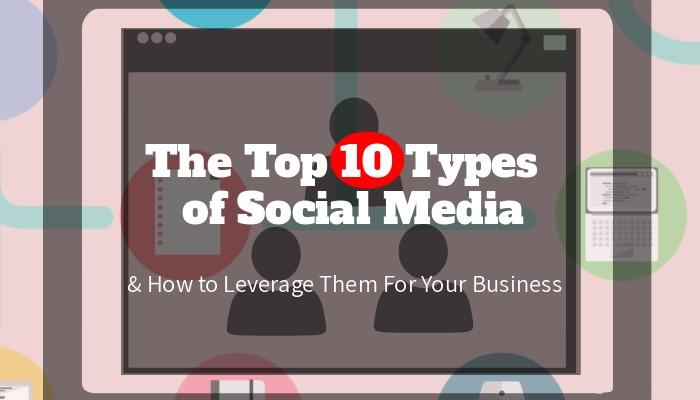Discover the five types of fonts and how you can use their inherent symbolism for your designs. Learn about their history, popular typefaces in Design Wizard and which types pair well for an effective text layout.
Find out how various industries and brands use typefaces to convey and underline their brand identity. Explore our downloadable and editable templates below to get inspired and craft unique designs.
Table of contents:
- ● Serif
- ● A Traditional Typeface for Elegant Designs
- ● Use Simplicity to Stand Out
- ● Make Your Design Elegant for a Classic Look
- ● Combine Distinctive with Neutral Types of Fonts
- ● Sans Serif
- ● Clean and Engaging Fonts
- ● Create an Eye-Catching Design with Sans Serif
- ● Grab Public Attention
- ● Go for a Balanced Look Between Ornamental and Unembellished
- ● Slab Serif
- ● Choose Vintage or Modern Types of Fonts
- ● Craft a Friendly and Modern Look
- ● Design Powerful and Engaging Logos
- ● Use Font Weight to Create Contrasts
- ● Decorative
- ● Use a Powerful Design for Greater Impact
- ● Dominate your Design with a Decorative Typeface
- ● Enjoy Creative Freedom When Designing Your Brand Logo
- ● Combine Style with Traditional Looks
- ● Script
- ● Create Elegant or Casual Content
- ● Create Elegant Invitations
- ● Make Important Events in Your Life Stand Out
- ● Pair Contrasting Styles for Your Unique Composition
Serif

Serif fonts are a traditional font type. You can recognize serif fonts by the small strokes that extend outward from each character. This classic design originated in the Roman period when serifs were created by flaring out brushstrokes at the top and bottom of letters.
These “feet” give serif fonts structure with a flourish and create the variety you can choose from for your design. Use font styles like Old Style, Transitional, Neoclassical, and Modern Serifs to convey gravitas and class.
A Traditional Typeface for Elegant Designs
Serif typefaces keep the eye flowing from one character to the next, which makes them incredibly legible. Designers typically use them for long stretches of printed text like documents, books, and magazines while the readability of serifs on-screen depends on display quality.
The heavy use in print media automatically conveys feelings of tradition, dependability, and practicality. Some types of designs also evoke authority and a sophisticated or cosmopolitan nature that is often used in the fashion, academic, or arts & culture sector.
Serif is a go-to font type for logos that display confidence and elegance or aim for a classic and established look. Brands like New York Times, Giorgio Armani, or Harper’s Bazaar show that the timeless look never goes out of style.
Trendy fonts you can find in Design Wizard are Alegreya SC, Lora, Tinos, and Triong.
Use Simplicity to Stand Out

This downloadable template is an example of a traditional use for print that conveys dependability and elegance. The text on this book cover is easily legible. Edit the template to experiment with your own combination of regular, bold, or italic styles.
The classic look of serif fonts like Crimson Text works well with the simple color design. It provides an opportunity to create a more playful background. We’ve created a striking contrast with shades of red and the pure white text that stands out clearly from the different red tones.
The use of a single icon is also an eye-catching feature on this book cover. Browse our vast Design Wizard library of icons to find one that fits with your design.
Make Your Design Elegant for a Classic Look

Serif fonts fit well with a sophisticated and elegant event like a classical concert. This editable event poster conveys timelessness and formality in line with the event.
Use a serif typeface like Tinos to focus on the most important information like name, time, date, and names of the musicians. Make sure you stick to one font family to convey this information and only vary it to create a contrast between headings, a link, and the rest of your content.
Take a minimalist approach to stay in line with the classic design and pair your chosen serif fonts with a minimum number of colors. We used colors that go together like black, white, and orange in this design to keep it simple.
To get a clear hierarchy, use headings in a different style that you can change easily in Design Wizard. Use the grid option to align and place your elements to create harmony.
Combine Distinctive with Neutral Types of Fonts

Combining the serif font Alegreya and the script typeface Pinyon Script creates an eye-catching and balanced look.
A script font like Pinyon Script has a lot of personality that grabs the attention of the reader, which makes it a great option for headings. It’s best practice to pair a distinct font like that with a more neutral one in the body text to make it more legible
Sans Serif

In comparison to serif fonts, sans serif typefaces lack the decorative finishing strokes. It was developed for advertising and commercial communication in the mid-19th and the 20th century.
The crisp, simple, and modern style is easier to read in a digital format. Efficient and economical, font styles like Futura and Helvetica have become iconic and widely used.
Clean and Engaging Fonts
Sans serifs are more youthful with connotations of simplicity, purity, and functionality. Sans serifs are clean and engaging, which makes them perfect for headlines. The lack of decorative elements also makes it an honest, straightforward, and sensible font family.
Brands use sans serif to appear more relatable, contemporary, and laid-back. Fashion labels like Dolce & Gabbana and Calvin Klein go for the more relaxed implications of this font style.
Companies like Google, Panasonic, and Toyota use the aesthetic of sans serif in their logos to look more approachable. It’s a popular typeface with tech businesses like Linkedin and Spotify because of their simple and effective nature.
Find popular examples of sans serif fonts in Design Wizard, such as, Alegreya Sans SC, Assistant, Averia Sans Libre, and Cabin.
Create an Eye-Catching Design with Sans Serif

The modern and engaging style of sans serif fonts like Anton works well for exclusive sales offers and promotions. In our editable advertisement, Cyber Monday stands out in bold letters to grab your customers’ attention.
Use contrasting colors for your designs to pull viewers in and then give them more information. For example, turn this downloadable template into a social media post with a call to action and a link to a landing page about your special offers.
Pick light colors for your sans serif font with Design Wizard’s color picker tool to stand out from darker background colors. We used white to generate a contrast with red and black. Make sure, you’re not selecting too many colors for your copy and design to avoid overwhelming your customers.
Grab Public Attention

Use the attention-grabbing nature of sans serif fonts like Cabin for important public information or warning signs. Without any decorative strokes, this typeface guarantees accessibility and legibility.
The font style strikes a balance between formal and informal, making these types of designs less aggressive even if it’s about rules. The informality levels the design or the authority behind it with the reader and makes them equals. This helps to convey that this guidance is in place for a reason, which is to keep everyone safe.
Signs like our editable template work better with lighter colors that evoke positive emotions. We used the color symbolism of dependability and trustworthiness of blue to put viewers at ease.
Go for a Balanced Look Between Ornamental and Unembellished

Find a balance between a sans serif font like Alegreya Sans SC and a serif font like Crimson Text to create an appealing text design.
The difference between serif fonts with their strokes at the end of each character and sans serif typefaces without any embellishment work well together. Make sure you use styles that don’t contrast too much to avoid unattractive combinations.
Slab Serif

Slab serif first emerged in advertising in the 19th century, as a way for publishing houses to make prints like posters and pamphlets more noticeable. This typeface is more blocky and squared-off than traditional serif fonts. The block lines at the end of strokes can be curvy or more prominent and unbracketed.
Slab serif is slimmer and more modern while retaining the readability and classic qualities of the serif font family. Instead of using bolded or italicized words, consider using a slab serif style to point out important information in your text.
Choose Vintage or Modern Types of Fonts
Due to the block style of slab serif fonts, they have connotations of confidence and solidity. Use these typefaces to make a stance or create a vintage vibe through the historic connections with print publishing. Slab serif fonts like Courier were designed for typewriters and printing machines. Tech companies like IBM and Olivetti still use them for their products.
If you want to convey a contemporary and friendly brand identity, experiment with slab serif styles for your logo. Classic typefaces of slab serif work well for outdoor brands. More modern versions feel artsier due to styles that are reminiscent of text produced by typewriters.
Brands who want to have an impact on the market with innovations like car and technology companies, use slab serifs to take a bold and dramatic stance with a touch of timelessness. Companies such as Honda, Sony, and Mozilla make use of the modern creativity slab serif conveys.
Make sure you check out popular slab serif typefaces in Design Wizard like Arvo and Josefin Slab.
Craft a Friendly and Modern Look

Slab serifs are closer to sans serif fonts making these typefaces bolder and a good way to highlight important information. In our editable template, we used a simple background to make the words stand out even more than they do in the bold Arvo font.
The larger title reels you in and the hierarchy created with a smaller date and call to action in all caps makes you read more automatically. This design makes use of the contemporary and modern connotations evoked by slab serif, which fits with the expectations of receiving the latest information in a webinar.
Ensure your text is centered in the ad to make it more appealing and use light colors to underline the associations of confidence and friendliness. You can use the same type of font for your call to action but make sure you set it against a distinctive background like the red color we used in our design.
Design Powerful and Engaging Logos

Slab serif fonts include powerful and engaging styles like Josefin Slab that are well suited for logo design. It’s important to find the balance between your typeface and the rest of your brand logo.
In our downloadable template, the size and style of the text stand in harmony with the icon. This works because neither the icon nor the words are too bold or eccentric. The contrast between the heading and sub-heading is crucial for visual appeal.
The added text helps with brand recognition, as it highlights the business name and what the company does. We picked blue here for its trust-building and calming associations. The pastel hue blends into the background giving prominence to the logo.
Use Font Weight to Create Contrasts

Bold slab serif fonts like Josefin Slab attract attention while regular sans serif styles like Libre Franklin generate a contrast that makes this a great font pairing.
The difference in font weight creates a clear visual hierarchy. Don’t just bold your headings but consider the contrast of a more eye-catching typeface for a header and a more neutral font for legible body text.
Decorative

Decorative fonts are creative and diverse with unorthodox letter shapes and proportions that often create a dramatic effect. In recent years, vintage-style and futuristic-looking decorative fonts have become increasingly popular.
Typical applications of decorative fonts are logos or the main title of a print piece. To make these creative types of fonts easier to read, they’re often one of the largest elements in a design.
Use a Powerful Design for Greater Impact
Decorative style fonts are used to not only evoke but provoke an emotional response. You’re working with extremes like an uncompromising elegance or a jarring effect. Typefaces that have decorative elements are also quirky and add flare to your design.
These highly stylized fonts are an ideal way to convey a casual, direct, or fun personality. Brands that require a strong typographic statement or want to capture the spirit of creativity and their uniqueness use decorative font types. For example, companies like Toys R’Us, Lego, and Disney use this and the connotations of playfulness in their logos.
Popular decorative font styles in Design Wizard are Bonbon, Butterfly Kids, Mr Dafoe, and Nosifer.
Dominate your Design with a Decorative Typeface

A decorative font works well on its own or when the goal is to dominate the design with your brand name. You can express your brand identity through typography, particularly, if you’re looking to convey excitement, entertainment, or quirkiness.
In our downloadable template, the style of Nosifer reminds us of a freshly poured beer with pearls of water dripping down the side of the glass. This sensation is what attracts customers’ eyes. The icon on the left underlines the mental image while the typography is bold and dramatic in the foreground.
If you’re using a decorative font for your logo, ensure any other elements of your design are kept simple like the icon in our editable template. This will both give more prominence to your brand name and prevent your customers from being overwhelmed.
Integrate your brand colors in your company name as well as the background design. In Design Wizard, you can enter hex codes to find the relevant colors easily.
Enjoy Creative Freedom When Designing Your Brand Logo

The decorative font Mrs Sheppards has a conversational style and carries a sense of lightness that fits well with the text “Heavenly” and the context of gaming. Our editable template makes full use of the creative freedom decorative fonts provide.
You can experiment with different styles while you’re shaping your brand identity to determine the font that is right for you. Brand colors add to that and in our downloadable design, black with its connotations of power, luxury, and mystery generates a contrast with the lighter blue that is often used in the entertainment industry.
Limit your use of decorative fonts to a key element to avoid overwhelming your audience. In our logo design, we used Mrs Sheppards for the brand name only to make it stand out more. For ease of use when arranging your design you can put the text and background design on different layers in Design Wizard.
Combine Style with Traditional Looks

Decorative fonts like Spirax and serif fonts like Averia Serif Libre are complementary combinations. It’s the opposing nature between a highly stylized and outgoing decorative style and the traditional and classic look of serif types that gives this combo its power.
This contrast makes it easy for designers to create a hierarchy with decorative typefaces featuring more prominently while serifs are more neutral.
Script

Based on the historical practice of custom designs made by engravers and sign painters, the script font family imitates handwriting, calligraphy, and cursive. It includes more formal typefaces that are used sparingly in designs but also unique fonts like the decorative types.
The decorative curls, flourishes, and loops make script styles unsuitable for longer blocks of text. They are more effective when used for headings, logos, or slogans. To keep your text easily legible, avoid using a larger point size or all caps.
Create Elegant or Casual Content
Script font styles range from fancy and sophisticated to trendy and relaxed. They have associations with elegance or may communicate a whimsical mood. Some styles are associated with femininity while others have the look of a masculine scrawl.
Historic handwriting styles from the 17th and 18th centuries with their flourishes or swashes convey formality while 20th-century style scripts are more casual with less decorative elements.
The handwritten feel helps brands like Virgin, Kleenex, or Kelloggs to create a friendly and approachable look in their logo designs. Coca-Cola, Instagram, and Cadillac are iconic brands that use script fonts to stand out.
Choose your favorite from popular script fonts like Chicken Script, Dancing Script, Parisienne, and Yellowtail in Design Wizard.
Create Elegant Invitations

The script font Alex Brush evokes elegance, which works well in combination with the champagne glasses in our downloadable template. Script is a font family that encourages creative experiments like making the first letter larger than the rest of the word to draw readers in.
Script typefaces are commonly used for invitations to events or gift cards to help add importance to the design. The white font stands out against the purple background with its connotations of exclusivity.
Be careful to not overwhelm the audience and use script styles sparingly. If there’s any other information, you need to add, use a use a more legible serif font.
Make Important Events in Your Life Stand Out

The script font Yellowtail in this editable design is a bit more playful to fit with the context of a newborn’s baptism. It’s used in the title to grab attention and elevate the message conveying the importance of the event.
The softer tones of blue used for the text and design create consistency and strengthen the association with children. Make sure you only use a script typeface in the heading to lead readers into taking in the rest of the information.
As the script font family encourages creativity, we used icons that you can find in our Design Wizard library that underline the religious connotations of the baptism.
Pair Contrasting Styles for Your Unique Composition

The script font Dancing Script and sans serif typeface Fira Sans pair well together through the contrast they generate. Font families that are like opposites in style combine better than fonts that are too similar. Use this to establish a hierarchy in your design.
For example, add personality to your composition with a script heading while sans serif types are more suitable for long stretches of text underneath a script title.
Finding the right font type that fits your brand identity is not an easy task. Use the above go-to guide with downloadable templates to help you discover a suitable typeface and create effective designs that convey the associations you’re aiming for.
Our practical examples are editable to kick off your design process and get you inspired. Make sure you pair fonts to increase legibility and make your business stand out. Once you’ve found the right combination for your business, stick with it to generate a consistent brand image.

Elisabeth Strasser
Having graduated with a Professional Writing MA with distinction, Lizzie set out to gain her copywriting and digital marketing experience in Cork City.
An Austrian with a love for Ireland, Lizzie loves exploring Irish folklore and storytelling. Her favourite DW tools are: Youtube Outro Maker and Add Logo to Video tools.


